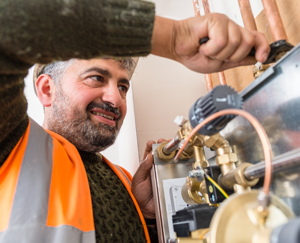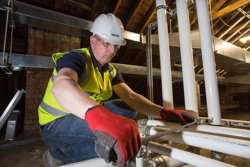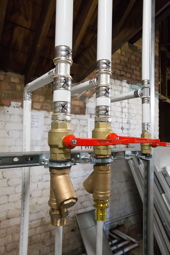Fit for purpose

Dave Lancaster discusses why commissioning of pipework is so important, and shares his insights on the best approaches to this vital process.
Commissioning is the last opportunity to identify any installation errors or faults in materials or components before a building is occupied. It is also an essential line of defence against health and safety risks, leaks or unsatisfactory system performance. The process proves the system is ‘fit-for-purpose’ and that it can perform as planned.
All commissioning should be carried out by a qualified commissioning engineer in line with guidance issued for a recognised standard, such as CIBSE Commissioning Codes, Water Supply (Water Fittings) Regulations 1999, EN806-4 or Scottish Byelaws 2004.
As a process that is so critical for ensuring the system is safe and fit for purpose, commissioning must be methodical and test the installation to its full operational capacity or beyond. This ensures that the pipework delivers its full design life without leaks, significant loss of pressure or health and safety risk, with a fully-documented outcome to enable verification of the process.
 |
Core competencies
Commissioning may be the final stage of a pipework installation project but the groundwork for successful commissioning needs to begin before the first piece of pipe is even installed, with the training of the installation team. This should not only involve the required mix of plumbing qualifications and experience on site, but should also encompass verifiable competence in installation of the specific pipework system to the manufacturer’s guidelines.
Indeed, some commissioning engineers refuse to even begin checks on the system itself until they have checked the installation team’s competence in installing the system. Consequently, the contractor should always ensure that training certificates are available to the commissioning engineer along with documentation to evidence that the pipework has been installed to the client’s requirements, the manufacturer’s prescribed methodology and the mechanical consultant’s specification.
For example, for pipework systems where expansion compensation is required, each member of the installation team should be able to demonstrate that they understand expansion and can control the movement properly. It is not viable for the commissioning engineer to check every joint and many may be inaccessible for checks once the building is ‘closed in’ so general confidence in core skills is vital.
Clean and tidy
The pipe manufacturer also has a key role to play in easing the commissioning process. Detritus, dirt and bacteria in poorly packaged pipes stored on site can raise issues during flushing of pipework, so systems that are packaged hygienically can be a significant advantage. For example, Uponor’s MLC (multi-layer composite) pipes are individually capped immediately after manufacture and packed as single units or in very small numbers to avoid issues of cleanliness in the newly installed system. Where possible, the installation team should maintain this clean approach by covering the exposed ends of pipe. In this way, they can help to speed up the commissioning process by keeping the pipework as clean as possible, reducing the amount of flushing required.
 |
On larger installations, the mechanical contractor may need to carry out pressure testing on some areas of the pipework during the programme to ensure that there are no errors on the system that could be difficult to resolve or cause subsequent problems. Where this is the case, a detailed pressure testing log should be kept for inspection by the commissioning engineer so that previous testing can be verified. To avoid the risks of stagnant water in the system, which could cause biofilm build-up or bacterial growth, there should be as little time delay as possible between pressure testing using water and the system becoming operational. However, if they prefer to check joints prior to commissioning this should be done on a floor by floor basis.
Under pressure
The pressure testing regimes used at commissioning often vary depending on the type of pipework used because the test is designed to identify any weaknesses in the connections. Traditional systems usually involve a greater number of connections and the stability of each connection relies on the correct depth of the tube within the fitting and the quality of the solder, the integrity of compression fitting or the tightness of the threaded fitting. Even when using modern metal press systems, there is no way of verifying this type of joint apart from at high pressure or by using x-ray equipment, which is costly and time-consuming. Consequently, clients and commissioning engineers sometimes insist on extremely high test pressures.
However, there are alternatives to this approach, as some pipe systems today offer technology that allows for easier verification of connection integrity. This includes press joint indicators and press inspection windows to verify that the joint is secure.
 |
| Pipe systems today offer technology that allows for easier verification of connection integrity. This includes press joint indicators and press inspection windows to verify that a joint is secure. |
This means that all connections can be reviewed and documented during installation, and the system can be tested at lower pressures. This not only ensures that the commissioning process is safer for everyone, it also safeguards the mechanical plant from any faults that may occur due to excessive high pressure on the system.
To pass the commissioning process, the installation should maintain zero loss of water pressure across the system.
The final test
Ideally commissioning should be carried out by an independent engineer who has no vested interest in signing off the paperwork to ensure that the installation meets all safety and compliance requirements in line with both the manufacturer’s guidelines and the client’s brief.
The final tests should include installation observations for joint expansions, pipe runs, pipe fixings, insulation etc, along with operational observations including temperatures, pressures, flow, valves, plant efficiency, pumps etc. Once visual and operational inspections of all elements of the installation have been carried out, the pressure test can be completed. Finally, the system should be cleaned and flushed to ensure removal of any detritus and disinfection or chemical treatment, depending on the type of system.
Dave Lancaster is applications specialist at Uponor







